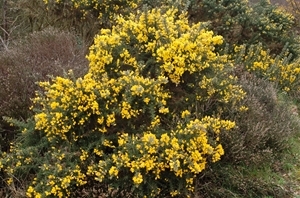Gorse
 What wild plant in Britain can you see in flower on every day of the year? The answer is common gorse (Ulex europaeus). Hence the saying, “you can only kiss a girl when the gorse is in flower!”
What wild plant in Britain can you see in flower on every day of the year? The answer is common gorse (Ulex europaeus). Hence the saying, “you can only kiss a girl when the gorse is in flower!”
Gorse is often known locally as furze or whin, while in Devon it is sometimes called Dartmoor custard as at certain times of the year it turns whole hillsides completely yellow! Not many people realise that gorse is a legume, so that it can produce its own nitrogen which helps it to thrive on free draining soils with low fertility. In fact common gorse can grow on most soil types; however it is not a particularly hardy plant and frequent severe frosts can kill it, which is why it is not found at altitude in the north of the country. The plant seeds freely and can readily colonise disturbed ground, sometimes becoming highly invasive.
Gorse disperses its seeds by having long pea-like pods that twist and explode when they dry out, throwing the contents up to 2m away. Red ants also often help with dispersal by transporting the seeds up to another 4m further on. They’re attracted by the covering of fat, protein and sugar on the seeds and so collect them up, carrying them back to their nest to feed to their broods. The ants are only interested in the nutritious coating, discarding the actual seed unharmed, so that it can still germinate.
Gorse is highly flammable and has long been used as a fuel, especially by bakers who used bundles of gorse to fire traditional bread ovens. It was cut down every three years or so over wide areas for this purpose. The flammability of gorse actually helps the plant on occasions as it is well adapted to withstand flames, having evolved seed pods that are opened up by fire, thus allowing rapid regeneration after a burn. The burnt stumps also readily sprout new growth from the roots, so burning is often deliberately used in order to encourage new growth, the fresh sprouts providing easily accessible food for stock.
This brings me onto the other main use of gorse: that of a fodder crop. Gorse has about half the protein content of oats and is therefore viewed as a cheap alternative. As a general guide it was said that an acre of gorse could provide enough winter feed for six horses! Goats and horses can strip the leaves and eat them straight from the plant but it was usual practice to run the branches through stone mills or hit them with wooden mallets, so as to crush the thorns and reduce them to a moss-like consistency, which made it more palatable, especially to cows and sheep.
Gorse also offers a fantastic habitat for a range of wildlife, some of which are strongly associated with the plant. The Dartford warbler, stonechat and whinchat (the “whin” part of the name emphasises the close connection) all frequently use gorse to live in. It is an important plant for bees because it flowers over such a long period, while on occasions whole areas of gorse can be completely covered in spiders’ webs, showing how favoured the plant is by this group of arachnids. One particular species known as the gorse spider mite which is about half a millimetre long and bright red, lives in colonies on gorse and can produce huge cobweb-like sheets of silk covering many bushes, which on a bright early morning following a heavy dew can look absolutely spectacular!
Gorse was sometimes used by families at Christmas time as a substitute for mistletoe. A kissing bush, as it was known, was made by taking a small gorse bush and dipping it in water and then sprinkling it with flour to get a snow effect. This would then be put in a pot covered with silver paper and holly berries stuck onto the thorns. People would then kiss next to the kissing bush as opposed to under the mistletoe!
Due to its evergreen nature and bright yellow flowers – which can be seen the whole year round – gorse is seen to carry within it a spark of the sun’s life giving energy, a glimmer of hope even through the darkest winter months. It is therefore a symbol of encouragement and a promise of good things to come.
So next time you pass a clump of gorse, pause a while to look more closely and if the day is warm, smell the flowers and take in the strong coconut scent it offers – yet another surprise that the plant has to offer!
Peter Thompson
Advisory
Read more from Peter Thompson at the Fresh from the Field blog.

Download Peter Thompson's essential 26-page book, featuring beautiful photography and detailed profiles of Britain's wildlife
Download FREE >